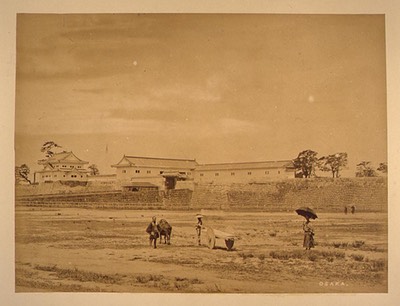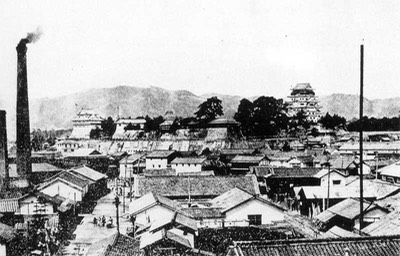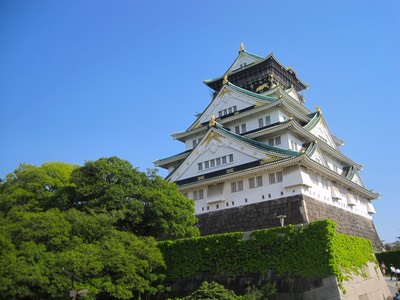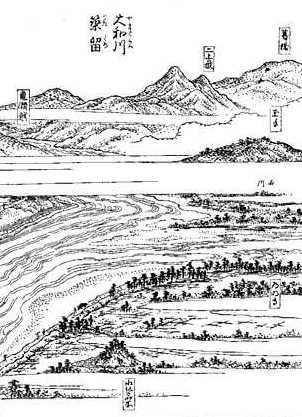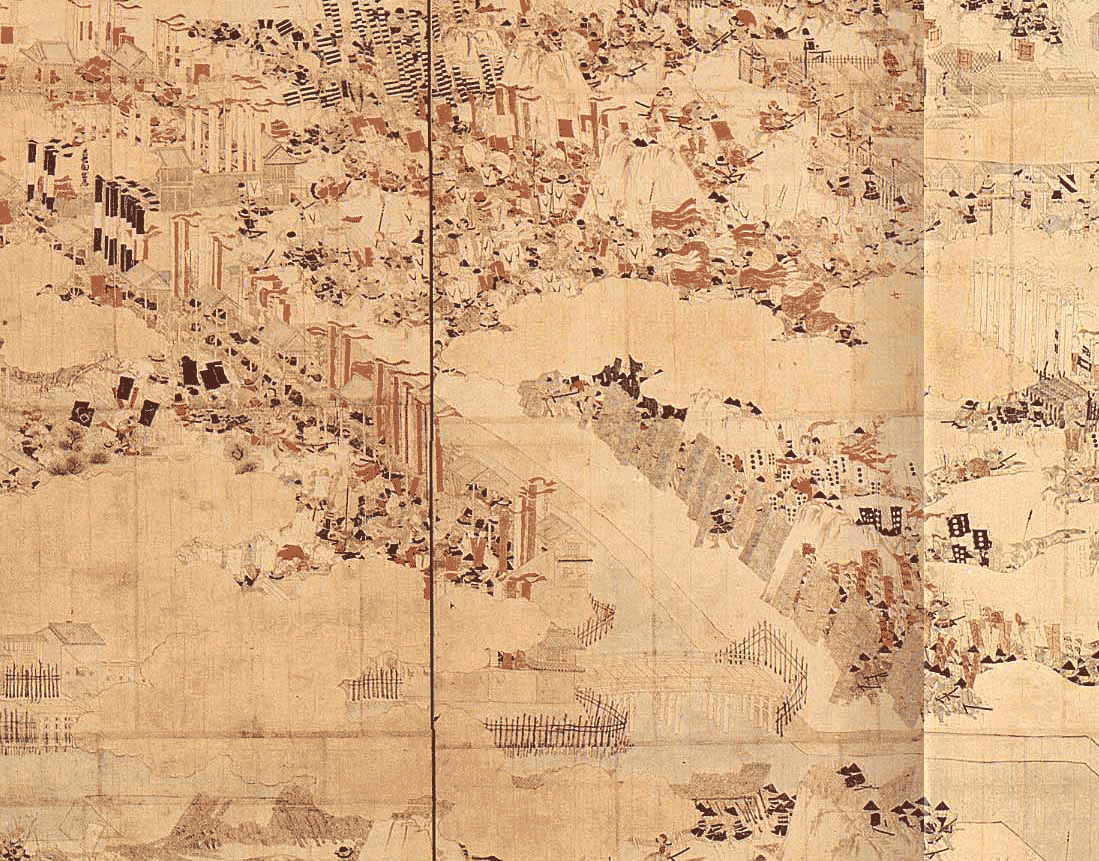One of the most insightful documents relating to Musashi's whereabouts during the siege of Osaka castle is the Kōkō zatsuroku. It's author was Matsudaira Kunzan (1697–1783), a Confucianist scholar-warrior who was born in Nagoya and, at the age of twenty, entered the service of Tokugawa Tsugutomo, then lord of the fiefdom of Owari (in today’s Aichi province). In 1743 Kunzan was appointed kakimono bugyō, the magistrate in charge of the fiefdom’s immense archive (which comprised some 3700 documents), a post he was to occupy for the next thirty-eight years. Kunzan's intimate knowledge of the Owari archive that he built up in the course of his career gives considerable credence to his claim that during the Osaka campaign Musashi was fighting among the troops of Mizuno Katsunari (1564–1651):
大坂の時、水野日向守か手に付、三間ほとの志ないのさし物に、釈迦者仏法之為知者、我者兵法之為知者と書れる。よき覚ハなし、何方にて有れん橋の上にて、大木刀を持、雑人を橋の左右へなぎ伏れる様子、見事なりと、人々誉れる。
During the siege of Osaka castle, Musashi, who was fighting with the troops of Mizuno Hyūga no Kami [Katsunari], carried a five yard long banner on which in bold characters was written the slogan: “Men from the realm of Shakya knew and practiced the laws of Buddha; we know and practice the laws of heihō.” I do not remember exactly where it was, but at one stage he was standing on a bridge, brandishing his long bokutō, and being cheered on, he cast the enemy troops off the bridge left and right.
Where the Kōkō zatsuroku isn’t clear about the precise place and time of the event it describes, an excerpt from the Mizuno Katsunari oboegaki, the personal diaries of Mizuno Katsunari, helps us to give the described events a time and place. Casting his mind back to the days leading up to the summer siege of Osaka castle Katsunari recalls how:
片山の山から後藤軍を下へ追い崩し、道筋両側は深田にて、田の中に小さき石橋あり、先に拙者二番に中山勘解由、三番に水野美作守、四番目に村瀬左馬、それを乗り越すと、本多左京の軍勢が追い崩され、その橋の際まで逃げかかってきたので、右四人の者、馬より降り槍を取って突き掛かり、敵を退け、藤井寺まで進撃した。
Driving down one flank of the mountain we pursued and crushed the Gotō forces and since both sides of the path were deep with mud, there was a small stone bridge amid the rice paddies. I was the first to mount the bridge, followed by Nakayama Kageyu, Mizuno Katsushige, and Murase Saba, and passing the bridge, we drove back the forces of Honda Sakyō, and since the latter also fled into the paddies flanking the bridge, we dismounted from our horses and taking our lances, pursued the enemy all the way back to Fujiidera.
It follows with near certainty that the Kōkō zatsuroku relates to the fighting during the summer campaign, which reached its climax during the first days of Juni, 1615. On June 2, Katsunari’s troops (which were part of a Tokugawa force of some thirty-eight thousand troops advancing on Osaka castle from Yamato province) were intercepted by a vanguard of some three thousand men under the command of Gotō Mototsugu at a place called Dōmyōji, some ten miles south-west of Osaka. Heavy fighting ensued in which Mototsugu was eventually killed and Katsunari’s men prevailed.
Not surprisingly, being a record describing Katsunari's own feats and those of his clan members, the Mizuno Katsunari oboegaki only mentions the main participants in the battle. Naturally they would have been leading large numbers of troops over the bridge in their pursuit of the enemy. Knowing that Musashi was one of the ten mounted guards attached to the seventeen-year-old Katsushige, it is safe to assume that the events as described by the Kōkō zatsuroku are those that took place on the bridge near Dōmyōji on June 2, 1615.
Indeed, it may well have been Nakayama Kageyu, the second retainer to follow Kagekatsu, whose recollections were passed down to his sons and their sons to finally be recorded by Matsudaira Kunzan when he visited Kageyu’s descendants to record their history. It was among the archives of the Nakayama clan, after all, that one of the two roll calls (the Osaka ojin no otomo) carrying Musashi’s name was discovered (see below).
Oddly enough, while the popular view (especially in the West) is that Musashi fought on the side of Hideyoshi’s forces (i.e., the castle’s defendants) there are no historical records to support such a view. Perhaps chiefly to blame is again Yoshikawa Eiji, who as stated above, had cast Musashi already on the side of the western, losing, forces of Ishida Mitsunari during the decisive Battle of Sekigahara (1600). As stated above, there is no record to support Eiji’s scenario.
Eiji might have based this version of events on the knowledge that, in order to raise enough troops, the Toyotomi generals mobilized more than a hundred thousand of rōnin, and since Musashi was such a rōnin for much of his life, his desire to cast Musashi on the losing side might have seemed justified. Having accepted that Musashi fought against Ieyasu’s forces at Sekigahara it was only logical to assume that he did the same during the siege of Oasaka castle.
This, however, is to ignore evidence to the contrary. And in contrast to the above view, there is ample and sound evidence to support the view that Musashi actually fought on the side of the Tokugawa forces under the command of Mizuno Katsunari (1564–1651). Apart from his appearance in the Kōkō zatsuroku, Musashi’s name appears on a roll call of men who fought under Katsunari titled Osaka o-jin no otomo. This record was rediscovered in 1984 among the possessions of a certain Nakayama Fumio (Nagoya), a direct descendant of Nakayama Shigemori (Shōgen), who was one of Katsunari’s chief retainers.
It is, by the way, believed that during the Kan’ei era (1624–29) Musashi visited Mizuno Katsunari at his stronghold of Fukuyama castle. During his visit he stayed at the yashiki of Nakayama Shigemori, who held a banquet in honor of his guest. A stone which had become Musashi’s favorite place to sit while sojourning in his host’s garden. Though Shigemori’s yashiki has long since been destroyed, the stone has been moved to the precincts of the Bingo Go-kuni shrine, situated on the castle ground’s norther perimeter, where it graces the temple grounds under the name of Musashi Meisō Ishi (Musashi’s Meditative Stone).
The Osaka o-jin no otomo is not the only roll call to mention Musashi’s name in connection to the siege. A similar roll call, kept among the archives of Fukuyama castle confirms that Musashi was one among the 230 mounted warriors (in addition to some 4300 warriors on foot) mobilized under Katsunari’s command. The roll call, titled Osaka o-jin o-ninzu tsukeoboe, originally was among the papers of the Oba, a clan of Mizuno retainers from Fukuyama. Today, two copies, one drafted in 1752, the other in 1818, are still kept in the Kagami Yagura, the castle’s eastern turret, and both carry the name of a certain Oba Heiba.
Moreover, not only does the Osaka o-jin o-ninzu tsukeoboe mention that Musashi was among Katsunari’s mounted warriors, it explicitly states that Musashi was the fourth among a group of ten mounted warriors attached to none other than “Sakushū-sama”, the honorary name of Katsunari’s son, Katsushige. Two men among the remaining nine are marked as “taking part as rōnin”, whereas no such label is put on Musashi.
Finally, as pointed out above, it was following the siege of Osaka castle, that Musashi adopted his first son, Mikinosuke. That much is borne out by an ancestral record drawn up in 1696, and submitted to the administrators of the Okayama fiefdom in the province of Bizen by a certain Miyamoto Kōhei, a nephew of Mikinosuke and head of a contingent of ashigaru of Ikeda Masakoto (1645–1700), the master of Okayama castle, clan on a stipend of two-hundred-and-fifty koku.
Tracing back his family’s ancestry, Kohei claims that Kiminosuke was in fact the third son of Nakagawa Shimanosuke. Next to nothing is known about Lord Shimanosuke, except that he was a descendant of the lord of Nakagawabara castle in the province of Ise and that at some stage he entered the service of Mizuno Katsunari. Like Musashi, Shimanosuke, too, joined Katsunari in battle during the siege of Osaka castle. He did so as a mushy bugyō, or Magistrate of Warriors, and it is almost certain that he lost his life in the siege, for he disappears from the records in the wake of the battle.
Any queries of remarks? Launch or join a discussion at our new FORUM
